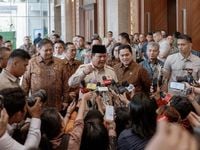President Prabowo Subianto’s first year in office has been nothing short of transformative for Indonesia’s economic landscape. As he delivered his inaugural state address to parliament on August 15, 2025, Prabowo painted a picture of a nation defying expectations: low unemployment, accelerating economic growth, and a bold slate of social welfare initiatives. Yet, beneath the surface of this optimism, deep questions linger about the sustainability and structural impact of his policies.
Prabowo, who assumed office in October 2024 after a campaign focused on rehabilitating his controversial legacy and promising rapid, state-driven growth, has wasted no time in rolling out his ambitious agenda. Central to his vision is a set of hallmark schemes—most notably the Nutritious Meals Program (Makan Bergizi Gratis, or MBG) and the Red and White Rural Cooperatives (KDMP)—that aim to address poverty, hunger, and inequality across Indonesia’s vast archipelago.
The Nutritious Meals Program, with a 2025 budget of IDR 121 trillion (roughly US$7.5 billion), targets 82.9 million recipients, including students and pregnant women. As Prabowo told parliament, “Our goal… is to be free from poverty, free from hunger, free from suffering.” By his own account, the program has already reached 20 million people, though official figures from April 2025 showed only 3.27 million had been served, highlighting the logistical hurdles of distributing aid across 17,000 islands. The program’s intent is noble—combating stunting and poverty—but its implementation has been rocky, marred by delays and even reports of food poisoning, according to Digital Journal.
To fund MBG and other social priorities, Prabowo’s government has made the controversial decision to slash budgets for infrastructure, education, and science by over 8% of GDP. This has had immediate and visible consequences. As reported by TEMPO.CO, a Rp50.59 trillion reduction in funds transferred to regional governments (TKD) began in February 2025 and is set to deepen, with plans to reduce transfers from 4.05-4.7% of GDP in 2025 to just 2.8-2.9% in the 2026 State Budget—a cut totaling up to Rp300 trillion. For some regions, this could mean a loss of up to Rp2 trillion in income. Between 60 and 70 percent of regional budgets depend on these transfers, and in some regencies, the dependence is as high as 87%.
The fallout has been swift and severe. Infrastructure projects, such as road and bridge improvements in Lima Puluh Kota Regency (West Sumatra) and low-cost apartment construction in Pasuruan (East Java), have been halted. The cuts have also hit physical special allocation funds (DAK), which finance schools, health centers, irrigation, and other public facilities. Economic actors from contractors to small food vendors have felt the pinch, and the quality of public services is visibly declining. “By cutting fund transfers to the regions, Prabowo is throttling the Indonesian economy,” TEMPO.CO editorialized, reflecting widespread concerns about rising inequality and eroding regional autonomy.
Yet these sacrifices are being made to bankroll Prabowo’s priority programs. In addition to MBG, the government has launched the KDMP initiative, seeking to transform 80,001 villages into self-sustaining economic hubs. Each cooperative receives up to IDR 3 billion in funding from a mix of state, regional, and village funds, plus state-owned bank support. The aim is to decentralize economic power and reduce the glaring income disparity between Jakarta—which boasts Rp72.9 trillion in locally derived income, 40 times higher than the average for eastern provinces—and the rest of the country.
The cooperatives are supported by the newly established Danantara Sovereign Wealth Fund, modeled after Singapore’s Temasek. Danantara consolidates state assets and channels investment into these rural initiatives, attracting high-profile backers like Jeffrey Sachs and former Thai Prime Minister Thaksin Shinawatra. However, the fund’s direct presidential control and lack of independent oversight have raised transparency and governance concerns among investors and watchdogs alike.
Critics worry that the KDMP could become a tool for political patronage rather than inclusive development. The Indonesian Ombudsman has flagged risks of mismanagement and corruption, warning that village heads and their allies may dominate cooperatives. Fiscal risks are also mounting: in a worst-case scenario, potential losses from these programs could reach IDR 85.96 trillion.
Prabowo’s penchant for state intervention extends beyond social programs. He has significantly increased defense spending—raising the budget from Rp166.1 trillion to Rp245.2 trillion—and has signaled a desire to influence monetary policy in support of his agenda. His admiration for China’s Deng Xiaoping is no secret; as Bloomberg reported, Prabowo often cites Deng’s economic reforms and resilience as a model for Indonesia’s own transformation. But investors are uneasy, questioning whether Prabowo’s ambitions are matched by realistic policies and sound fiscal discipline.
Those doubts are not unfounded. The fiscal deficit has reached its legal ceiling of 3% of GDP, forcing deeper cuts in non-populist sectors. The Ministry of Public Works saw its budget slashed by 70%, while the Ministry of Education and Technology faced a 25% reduction. These austerity measures have triggered public backlash, most notably the “Dark Indonesia” protests, where citizens voiced fears that short-term populist spending could undermine the country’s long-term growth prospects.
Despite these headwinds, Prabowo has pointed to positive economic data in defense of his approach. After negotiating a reduction in US tariff threats from 32% to 19% in April 2025—by agreeing to lower trade barriers for American goods—he celebrated second-quarter GDP growth of 5.12%, up from 4.87% in Q1, and a drop in unemployment to its lowest level since the Asian financial crisis. However, Capital Economics cautioned that the 2026 budget plan, with its ambitious revenue targets and soaring defense outlays, “looks optimistic and could lead to Indonesia breaching its fiscal rules.”
Investors are left weighing the risks and opportunities. On one hand, the MBG and KDMP could spur near-term demand for consumer goods and agribusiness, benefiting firms like Indofood and Astra Agro Lestari. State-owned enterprises such as Pertamina and PLN are central to these initiatives, but their performance will hinge on the government’s ability to manage fiscal pressures and avoid politicization. On the other hand, the rupiah’s depreciation to 16,868 per dollar in April 2025—a post-1998 crisis low—has heightened inflationary pressures, and sovereign bonds now appear a high-risk, high-reward proposition.
As Indonesia charts this new course, the stakes could hardly be higher. Prabowo’s social-driven economic strategy is a bold experiment in balancing populism with fiscal discipline. Its ultimate success will depend not just on the scale of its programs, but on their ability to foster sustainable, inclusive development—and to avoid the pitfalls of overreach and mismanagement that have tripped up so many before.





